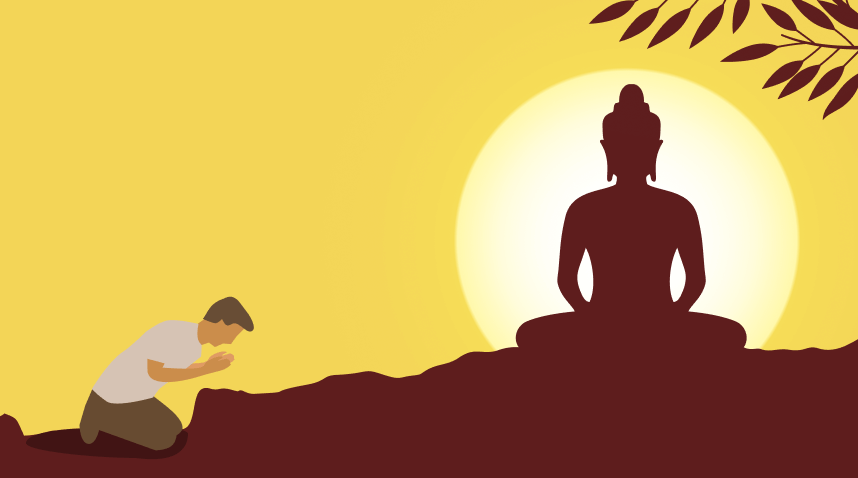TLDR: Friendship day through a Buddhist lens. Allen* reflects on his experience on the Buddhist version of friendship day known as Magha Puja where 1,250 monks gathered spontaneously 2,500 years ago.
*not his real name
An unexpected encounter in the fog of pollutants

During a brief exchange with Ajahn Achalo on the final day of our journey, he posed the question, “What are your impressions of the pilgrimage?” How does one respond?
Amidst the 400 Pollutant Standards Index (PSI) air, malfunctioning hotel heaters, and a longing for my pets, I found myself uttering to him, “It was almost life-changing”.
When I said that to Ajahn, my experience at Bamboo Grove came to mind, significant Buddhist milestones occurred at that site: The first generous donation of land to the Buddha and his Sangha; the first monastery where monks would gather and live together; and the first great gathering of the sangha, where the principal teaching, the Ovada Patimokkha was given.
Bamboo Grove vs Bodhi Tree
The Bamboo Grove was peaceful and quiet compared to the boisterous Bodhgaya, where you get triads of traditions gathering together to conduct their practice, most of them practising some form of an arms race of loudspeakers.
If the Buddha-to-be were to meditate under that same Bodhi Tree at Bodhgaya today, I doubt he would attain any form of awakening.
Standing amidst the serene Bamboo Grove, we found ourselves at the right place at the right time. It’s good to come with an experienced guide – Ajahn Achalo, a seasoned monk who has undertaken numerous pilgrimages to India in his unreasonable quest to complete 3,000 hours of meditation at sacred sites (he is already at 4,000 hours by the way).
Your predisposition will dictate whether it is a drawback or not, that he ceaselessly expects us to meditate at every site. And so we meditated.
A quiet appearance
After an hour of meditation, Ajahn signalled us to end our practice. I opened my eyes to the bright external reality, the whiteness from the marble floor reflecting the sunlight. There was another group facing us, quietly seated. The monks from our group offered flowers to the Buddha statue before us, then proceeded to greet the neighbouring group.
Curious, some of us went across to meet with the other group. Driven by a common Singaporean trait – “kiasu” or fear of missing out – I too, joined the group.
The neighbouring group was with Luang Por Thong Daeng. I sat near Luang Por while Ajahn had a cordial chat with him. Gradually, members from both groups began to intermingle. We bowed to Luang Por, while his entourage bowed to Ajahn.
Scrambling and gathering
While this was happening, some of my resourceful friends from the Dhamma Assembly for Young Working Adults (DAYWA) scrambled to find an offering for Luang Por. Despite the heavy 400 PSI pollution, the atmosphere was filled with a sense of reciprocal kindness and appreciation.
It was a beautiful scene, and I imagined how it might’ve been when the monks spontaneously gathered on that fateful night. Perhaps they too exchanged pleasantries or showed concern for each other. Perhaps they took the chance to share their practice.
Or perhaps, like us in that very moment, they simply sat in quiet companionship. At that moment, I felt a deep appreciation for the stories from the days gone by and felt how human the Buddha and his disciples were.
The honest bow of faith

After the warm exchange, I returned to our area to collect our mats and cushions. But a sudden urge to bow overwhelmed me. Feelings of reverence and gratitude took over me in a way that defied explanation. As I bowed to the Buddha statue, faith and energy surged, unlike anything I had ever experienced before.
Tears flowed as my head touched the earth. “Let them flow”, I thought to myself. I didn’t want to mask them with masculinity – I was rarely manly anyway.
Words cannot fully capture this profound experience. The unexpected encounter, with its remarkable resemblance to the story surrounding the Ovada Patimokkha, inspired me to deeply recollect the qualities of the Awakened One, to embrace the Dhamma, and to venerate the Sangha with immense gratitude in that single moment. Even now, recounting it gives me the goosebumps. How I wish you were there to share the experience!
Rethinking and reviewing what faith means
Faith is quite an enigmatic thing. Given my previous monotheistic, then skeptical atheistic background, I never would have expected myself to express faith in this manner. However, as I gradually tested various Buddhist hypotheses, it seems these little streams of tested faith gathered with gravity, and formed a whole body of evidence that ebbs and overflows into something deeply personal.
Thanks for allowing me to share this experience with you. If this piece was too “feely”, and you have a more skeptical and inquisitive mind, you may find this piece on my journey with doubt and faith more relatable. Until next time, keep the faith.
NB: So I told Ajahn Achalo that the trip was “almost life-changing”, but looking back, perhaps I broke the 4th precept. It was truly life-changing.
Wise steps:
- Learn and familiarise ourselves with stories from the Buddha’s time to understand the context of the teachings.
- It creates the conditions for us to develop a deeper appreciation of the Dhamma, by allowing us to put ourselves in the shoes of the characters in the suttas


